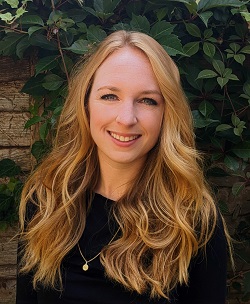Dr Allison Neal, Trinity
an596@cam.ac.uk

Biographical Information
I am a Junior Research Fellow at Trinity College. I came to Cambridge after completing my PhD at the University of California, Berkeley in 2019. From January to June 2022, I will be a Wallace Fellow at I Tatti, the Harvard Center for Italian Renaissance Studies.
Research Interests
I work on transnational modernism, twentieth-century American literature, poetry and poetics, and media (particularly sound) studies. More broadly, I am interested in literature’s transportability, examining how it moves between nations, languages, technologies, and art forms.
My first book project, Mass Vernacular: American Poetic Voice in the Era of Global Broadcast, examines American poetic voice at a moment when technology was changing the sound of language itself. While many critics dismiss voice as an outdated construct, associated with the subject-centered Romantic lyric or New Critical dramatic speakers, I argue that in the broadcast era, voice became the vehicle by which poems were actually made, circulated, and received. Throughout, I situate the poetry of Marianne Moore, W.H. Auden, Frank O’Hara, and Adrienne Rich in a broad institutional and technological soundscape: I trace how poetry intersects with both specific sound technologies, like the phonograph, the telephone, the radio, and the tape recorder, and a variety of vocal practices and institutions, including elocution instruction, live poetry readings, and radio-based forms of cultural diplomacy. Routing their poetry through modern circuits of communication, I argue, twentieth-century poets created a paradoxically intimate and global “mass vernacular,” as they envisioned lyric voices circulating in ways similar to other official and mass voices. Ultimately, by bridging the figurative and material dimensions of voice, my project seeks to restore the sound of American poetic voice to its larger acoustical range, enmeshed in the range of social institutions that simultaneously came to underwrite the nation’s global power more generally.
I am also at work on two other projects. The first, Florentine Modernism: The American Avant-Garde, Renaissance Art, and the History of the Aesthetic, recovers the importance of Florence, as both a twentieth-century metropole and an emblem of the Renaissance past, to American literary modernism. Focusing on three female modernist writers—Gertrude Stein, Mina Loy, and Mabel Dodge—it shows how the art and architecture of the Italian Renaissance past and the Anglo-Florentine community of the twentieth-century present inflected modernist conceptions of the relationship between self and setting. Inspired by the American mania for Old Master paintings in Florence, these writers used the artistic relics of the Renaissance to reinvent the category of the aesthetic. The second explores how twentieth-century poets and novelists imagined human mobility in a period that witnessed not only the freeform dancing of Isadora Duncan, but also the mass-produced automobile, Fordist factories, and the spectacles of fascism. Modern systems of mass transportation and organization, I suggest, produced a culture of “auto-mobility,” wherein human animacy was understood as something mediated and supplemented by external forces. Against this backdrop, choreographic writers like Jean Rhys, Gertrude Stein, William Carlos Williams, F. Scott Fitzgerald, and Claude McKay searched for new ways of capturing individual, auto-mobile bodies as they navigated the streets of industrial cities and the rhythms of mass culture, encountering emerging bodily disciplines like urban design and modern dance.
Selected Publications
"Frank O'Hara's Voice of America." ELH 86.3 (Fall 2019).
"Marianne Moore's Tone Technologies: Elocution, Poetry, Phonograph." Modernism/Modernity Print Plus 6.2 (Fall 2021). Peer-Reviewed. LINK
Review of Roi Tartakovsky, Surprised by Sound: Rhyme’s Inner Workings in American Literary History Online Review (forthcoming 2022).

